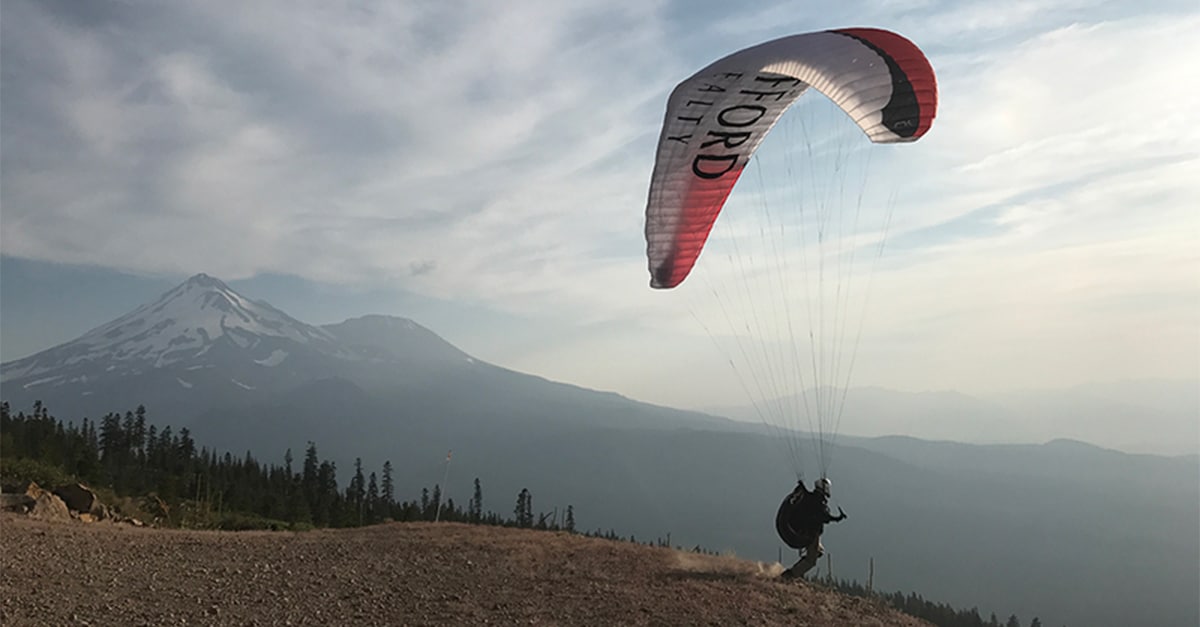Smooth Sailing
No limits in the sky with paragliding…
When he’s not selling real estate and hanging out with his family, you can find Tyler Clifford 3,000 feet off the ground, parasailing around Northern California. We caught up with him to chat about this hobby.
Enjoy: How did you get into parasailing?
Tyler: I was 19, working as a server at Red Robin in Redding, going to Shasta College. One of the other servers said she was going paragliding over on the coast. And I was like, “Really? What’s that?” And she goes, “If you want to learn, my boyfriend will teach you.” I was definitely curious. So I met him, this guy Patrick, and he took me out to Igo-Ono, a little 300-foot-hill and started teaching me. My first adventure paragliding, I drove out there, and my little truck got stuck in the mud. It’s a two-wheel-drive truck. And so here comes the instructor. I meet him for the first time, and he goes, “I’ll pull you out of the dirt.” He grabbed a paragliding harness, hooked it to my car and pulled me out. And he goes, “Yeah, you see that’s how strong our gear is.” That was my first learning that the harness is safe. I ended up becoming friends with him and just started flying. All through my early 20s in college, it became a routine thing. Flying Hat Creek Rim here and the Whaleback in Mount Shasta are the two main sites. Back then, we used to fly off Round Mountain after the Fountain Fire. Now the trees are grown in so you can’t fly there anymore.
Enjoy: Tell us about your first flight. Were you nervous?
Tyler: I was definitely nervous and excited – excited as you can’t wait for it to begin, nervous as you can’t wait for it to end. They work you up to it, so the first time you’re maybe getting 10 feet off the ground, and you land. So it’s real mellow. And then you go up to a 300-foot dell where you’re 100 feet off the ground maybe and you’re only going to have a flight that’s maybe 60 seconds long, but you do that a bunch and you work your way up, then you have your first altitude flight. And that is where you have your first real “aha” experience.
At Hat Creek Rim, you’re going to be 1,000 feet off the ground and you maybe go up 1,000 or 2,000 feet. So, you could be 3,000 feet off the ground very easily, and you’re going to fly for 30 minutes to three hours.
Enjoy: What’s the longest flight you’ve done by yourself?
Tyler: About three and a half hours at Hat Creek. There are two types of flying that we do mostly here – ridge soaring or cross country. With ridge soaring, imagine a river with a big rock in the middle of the river. That water or the wind is going up over that rock or ridge, and we’re basically surfing the front of that. We ride that until it finally dies out, we can’t stay up anymore, and then we go land. The second way of flying is cross country. That’s more of like the Whaleback in Mount Shasta. That’s where you’re launching and your thermal climbing, so you’re actually looking for heat. And you’re looking for that through rock croppings, maybe trees you can see shaking, you can tell they have heat. You’re going to try to find that rising air. The key is to stay in this course. You’ll see paragliders circling, and you’ll see the birds. You look at the buzzards and see them circling because they’re staying in that core of the thermal. It’s a lot more technical. The thermal flying takes a lot more experience to stay up. If you’re very experienced, I mean, you could launch in Mount Shasta and land somewhere in Oregon.
Enjoy: Does it push people’s limits?
Tyler: It pushes your limit. It makes me pray more. It keeps me close to God. It grabs all of my mind. They say when people meditate, they are clearing their mind, right? And it’s in a way, even though you’re highly active, it’s a lot of adrenaline. It’s mind blocking everything else. When I’m paragliding, that’s all I can think about, because I’m controlling the wing, it’s just me. If you don’t like being in 100 percent control, I wouldn’t recommend it.
It’s not a team sport once you’re in the air, but before you’re in the air, it definitely is. We’re all working together to decide, “Is it a good day to launch?” We’re checking each other’s gear out. We use the buddy system. There are five straps that you have to connect. We will say, “Hey, yeah, you look good. You look good to go.” And so, it’s a team sport before planning, deciding when to launch, and that kind of thing, but when we’re in the air, you’re all alone. And I like that. It builds your confidence. And like I said, I pray up there. It builds my confidence and it’s a stress reliever for me. It’s not like a walk in the park; I love that. It felt larger than life. It felt like it was impossible to do. And I’m just a kid in Redding, and I can work in Redding, and go jump off a mountain and have a big, big experience, and come right home and be at work the next day. •
Enjoy: You can stay up there for three hours?
Tyler: Absolutely. There are pilots now that are staying up all day and flying from California to Oregon and stuff. But that’s real extreme. My main goal is to take care of my wife and kids and go home, so it’s just fascinating to me to be able to leave work early at 4 pm, launch my paraglider at 6:30, landing at 9 pm. I’m home by 10 or 10:30 and it was all in a day. That’s really amazing.
Enjoy: How much does it cost to get one of those things?
Tyler: I’ve always personally defaulted to buying new with this kind of equipment. Just the wing you can buy for probably $4,000 to $6,000, depending on the type of wing. Then your harness, it’s like any sport, like ski boots, right? You could spend $300 or you could spend $2,000. Same with paragliding harnesses. You can get a harness for as minimal as $400 or $500, but you can spend up to a couple thousand. And then you’ve got your helmet, gloves and boots. So, short answer, for $5,000 to $8,000 you can be into paragliding, you can have all your equipment, and then it’s just gas money.
There’s no maintenance. We repack our reserve every year, which is $50. For training, there’s a paragliding school in Mount Shasta, AirXpansion, and Brian Kerr is an instructor in Mount Shasta. I’ve had a lot of instruction from instructors in Utah, the “paragliding mecca,” and I’ve done some simulation clinics where you do maneuvers. They tow you up in a boat and you’re collapsing your wing, doing spirals to learn how to react to them. You can be told, textbook-wise, how to react, but then you add that physical response, and you kind of can lose your mind.
You have to actually feel the physical response of that, maybe pulling two or three Gs, and then be able to still hang through that. We do all that over water, so in case we did fall, we have a higher chance of survival.
By Nigel Skeet
California Adventure District Experience
Photo courtesy of Tyler Clifford




